AFFILIATE MARKETING
Your Quick Guide To Mastering The Tool in 2023

Boom! You’ve caught wind of ChatGPT, and you’re fired up to join the AI revolution. Guess what? You’ve struck gold! Today, we’re delving deep into the “ChatGPT for beginners” topic.
I’ll break it down piece by piece, so even the greenest of ChatGPT neophytes can harness its potential.
So grab your gear, my friend, as I lead you on a quest to conquer ChatGPT and emerge a true whiz!
How to Create an Account with ChatGPT?
Getting started with ChatGPT is super easy! Here’s what you need to do:
Go to the ChatGPT starting page and look for the “Sign Up” button.
Enter your email address and create a strong password. You also need to agree to the terms and conditions.
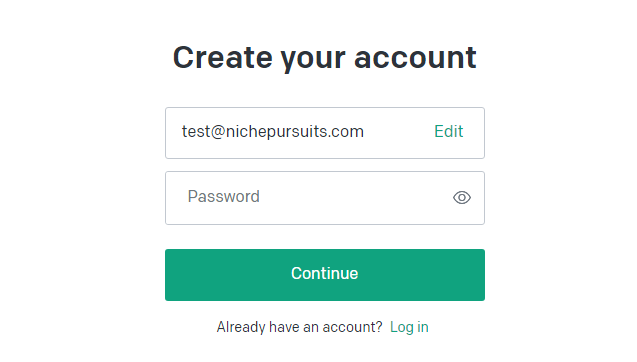
Check your email and confirm your account.
And just like that, you’re all set to start exploring the world of ChatGPT!
ChatGPT Capabilities
ChatGPT, the advanced AI language model based on GPT-4, offers remarkable capabilities, such as:
- Language understanding: ChatGPT will grasp context, sentiment, and nuance for sophisticated dialogues.
- Top text generation: Creates high-quality, diverse content for various applications.
- Multilingual skills: Bridges language gaps.
- Zero-shot learning: Tackles new tasks without prior examples.
- Integration: Works with other tech to enhance user experiences and streamline processes.
- Text/image parsing: Understands both textual and visual inputs.
In other words, it’s smart as hell. It’s even passing GRE, US legal, and medical exams.
GPT-4 is even more advanced than its predecessor, GPT-3.5.
While GPT-3.5 was already an impressive machine learning model that could pass the bar exam, it only scored in the bottom 10%.
GPT-4 takes things to the next level by achieving a top 10% on the bar.
Read the full GPT-4 technical report.
ChatGP Limitations
Although ChatGPT is a powerhouse language model, now and then, it might hit a speed bump.
ChatGPT sometimes “hallucinates” information, producing plausible but incorrect responses. These can occur when the AI doesn’t have enough accurate information to answer a question or misunderstands the context.
Open AI also implemented “guardrails” that prevent the AI from generating harmful or offensive content. As a result, ChatGPT will steer clear of any controversial or unsavory content.
Next, don’t forget about social biases. Since ChatGPT is trained on vast amounts of data from the internet, it inadvertently learns the social biases present in that data.
OpenAI CEO Sam Altman acknowledged some of these shortcomings:
What Types of ChatGPT Prompts Can You Use?
Looking to create compelling content with ChatGPT? You can use many types of prompts to inspire your writing, including prompts for:
- Generating ideas
- Solving problems
- Crafting content
- Creating outlines
- Summarizing text
- Reverse engineering text (into ChatGPT prompts)
- Organizing data
Ideation
Looking for fresh ideas? ChatGPT can generate topics for your SEO or tech blog posts.
Example: “Suggest topics related to mobile SEO best practices.”
ChatGPT might offer ideas like “The Importance of Mobile-First Indexing in SEO” or “Optimizing Page Load Speed for Better Mobile SEO Performance.”
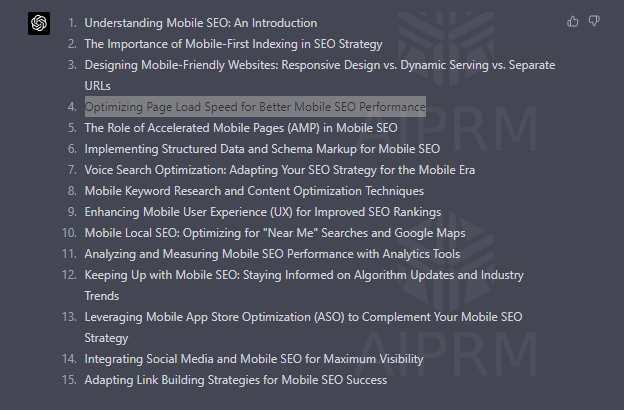
Problem-Solving
ChatGPT can help you tackle challenges. For example, I asked ChatGPT to solve one of the world’s most pressing challenges:
“How would you solve the massive challenge of natural resource depletion as the world’s population continues to grow, which puts a strain on resources and the environment?”

Long-Form Content Creation
Generate comprehensive long-form content by providing context.
Instruct ChatGPT: “Write a 1000-word guide on implementing structured data for SEO.”
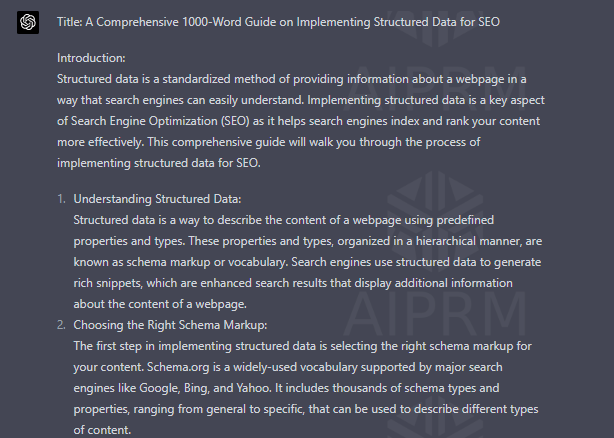
One major issue is that when you ask ChatGPT for an extremely long output based on a short input, you give up control of the writing process.
- The quality of the output may vary
- It might contain inaccuracies
- It lacks the personal touch that comes from writing something yourself.
So, always remember:
- Consider the input-to-output ratio.
- If the inputs are vague, the outputs will be surface-level.
I’m not saying that Google penalizes generative ai content (they don’t!). But don’t take that as a free pass to churn out robotic articles that lack depth or personality.
Remember, Google’s algorithms crave value, originality, and authenticity.
Bottom line: quality still reigns supreme. Use AI wisely, and you’ll strike gold with your content.
Outlines
ChatGPT can create outlines for SEO or tech projects. (We also cover how to use ChatGPT for SEO).
Example: “Outline a blog post on cybersecurity best practices for small businesses.”

ChatGPT will provide a clear structure with headers like “Understanding Cyber Threats” and “Implementing Cyber Security Best Practices.”
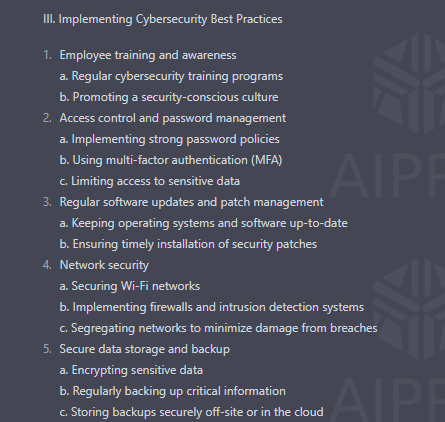
Content Summary
ChatGPT can summarize lengthy documents for you.
Example: “Summarize the key points from this Al Jazeera article on GPT-4 [URL].”

It will generate a concise summary highlighting the key points and findings.
Reverse Engineering Text
Have you ever encountered a piece of writing you wish to replicate? Reverse engineering text with ChatGPT involves breaking down the writing into a prompt that you can feed into the AI system.
This prompt can include information about the writer’s style, tone, structure, and any other details you want to emulate.
“[Instructions] I want you to take this [URL] and break it down into a prompt formula I can use for ChatGPT. You should provide:
- [context]
- [specificity]
- [tasks]
- [tone]
- [style]
- [main objectives]
Take the variables above and craft a detailed and cohesive ChatGPT prompt I can use as context before I write my article.
Do you understand? Don’t write anything yet.”
Next, drop ChatGPT your URL.

ChatGPT will provide an excellent starting point for writing your article.
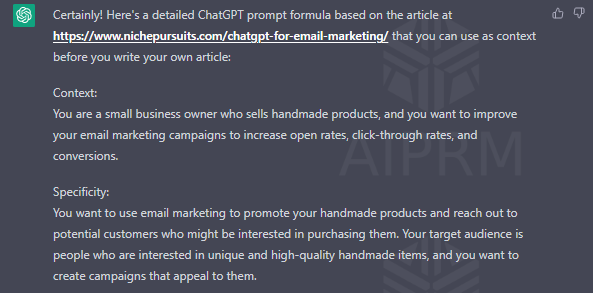

Remember, inputting the prompt directly into ChatGPT might not produce the most original results.
To make sure your output is distinctive, consider these tips to modify your prompts:
- Introduce a twist: Change the prompt to encompass a unique angle or viewpoint. You could, for instance, concentrate on specific industries related to your topic.
- Personalize the experience: Tailor the prompt by incorporating your personal experiences or opinions. Share any wisdom or lessons you’ve gained along the way.
- Elaborate on tasks: Dissect the tasks into smaller components, adding concrete examples or case studies. This encourages ChatGPT to deliver more comprehensive and varied information.
- Pose questions: Embed questions within the prompt to stimulate thought and encourage further exploration. For example, ask, “Can you think of any unexpected ways ChatGPT might assist companies in boosting their email open rates?”
Reports/Tables
Impress your audience with AI-generated reports and tables. ChatGPT can process data and present it in a visually appealing, organized manner.
Provide the AI with the necessary data, such as:
“Create a table comparing the capabilities of GPT-3.5 and GPT-4.”

Boom! You’ll receive a neat table showcasing the key differences, perfect for your next presentation.
Pre-Prompts
For customized responses, it’s crucial to provide ChatGPT with context beforehand. This could be a character’s backstory, project requirements, or a specific URL.
For instance, if you want ChatGPT to write a paragraph on how to improve website speed with a focus on a particular e-commerce platform, you could provide context like this:
“Use the following as context: We’re discussing website speed optimization specifically for Shopify stores.”
With this information, ChatGPT will generate a more targeted response that directly addresses Shopify optimization strategies.
Alternatively, if you have a webpage you’d like ChatGPT to use as context; you can simply provide the URL.
Example: “Use this URL as context: [URL].”
By doing so, ChatGPT will incorporate the information from the given URL into its response, making the output more relevant and aligned with the source material.
How To Use ChatGPT Prompts?
Here are some tips to enhance your ChatGPT prompt writing experience:
- Be specific: Try to ask focused questions or provide specific details. The more precise you are, the better ChatGPT can address your needs.
- Limitations: Remember ChatGPT’s knowledge cutoff date. One way to overcome the knowledge cutoff date is to provide ChatGPT-specific text you want to draw from. If that text includes knowledge beyond 2021, you can bypass the limitation.
- Instructions: Give explicit instructions to ChatGPT about the format you’d like the answer in – bullet points, numbered lists, or even a brief summary.
- Multiple questions: If you have several questions, break them down into individual prompts or group them logically.
- Alternate Perspectives: Request ChatGPT to approach a topic from a unique or unexpected angle, such as “Explain the importance of cybersecurity from a hacker’s perspective.”
- Roleplay Scenarios: Encourage ChatGPT to assume a specific role or persona while answering a prompt, like “As an SEO expert from the year 2050, what advice would you give to today’s digital marketers?”
- Imagine and Explore: Begin your prompts with phrases like “Imagine…” or “What if…” to inspire ChatGPT to think beyond conventional ideas. For example, “Imagine a world where AI can predict user behavior. How would this change marketing strategies?”
- Design and Invent: Challenge ChatGPT to create something original using the phrase “Design a new…”. For instance, “Design a new SEO tool that revolutionizes keyword research.”
- Test different approaches: Try rephrasing your prompt. Sometimes, a slight tweak can make all the difference.
ChatGPT for Beginners – Final Thoughts
Congratulations! You are now well on your way to becoming a ChatGPT top gun.
We’ve explored the basics of ChatGPT, how to create an account, its capabilities and limitations, and how to use it to generate content for your blog or business.
As a final thought, I recommend signing up for GPT-4 and experiencing the power of this next-generation AI language model for yourself. While I’m not affiliated with OpenAI, I believe in this technology’s incredible potential to transform how we work, communicate, and solve problems.
If you enjoyed this piece, you could continue learning about ChatGPT in the following articles:
ChatGPT for Beginners FAQs
Here are the ChatGPT for beginners frequently asked questions.
Is ChatGPT Free to Use?
OpenAI offers both free and paid plans for using ChatGPT. The free plan allows for limited usage, while the paid plan offers higher accuracy and reasoning.
How Accurate is ChatGPT?
ChatGPT is a highly accurate language model trained on a vast dataset, enabling it to generate coherent and contextually relevant responses. Open AI shows GPT-4 is 40% more accurate than GPT 3.5.
Can you use ChatGPT on Mobile?
Yes, ChatGPT is accessible via mobile devices, ensuring you can generate content.
How is ChatGPT Different from Traditional Machine Learning Models?
OpenAI’s website shows that ChatGPT (GPT-4) handles complex language tasks well because it can understand and analyze natural language data. However, the new version of ChatGPT is even more advanced than before – it can now handle up to 25,000 words at a time! Plus, it’s strong at following even the most subtle instructions.
AFFILIATE MARKETING
AI Will Transform the Workplace. Here’s How HR Can Prepare for It.

Opinions expressed by Entrepreneur contributors are their own.
Our workplaces are about to undergo an unprecedented level of transformation, and HR will take center stage. Artificial intelligence will dramatically reshape HR in a way that goes beyond recruiting, hiring and talent management. Leadership teams at all levels need to embrace this change to transform and lead their organizations forward.
It’s the people, and not the technology, that makes AI initiatives a success. Intrapreneurs, in particular, are the driving force behind it. As I shared in Fearless Innovation, I noticed this when I was working on the innovation agenda for the Great Places to Work study — the most innovative companies were those that had a leadership team that was embracing intrapreneurship and were open to change.
HR is the beating heart of any organization, and as such, it needs to take center stage in both adopting and leading ethical and innovative AI transformation across the organization.
Related: How Artificial Intelligence Is Reinventing Human Resources
4 tectonic shifts AI will drive in HR
1. A new wave of massive reskilling
As AI becomes more prominent across business functions, the need for new skills will only grow. Forty percent of enterprise leaders believe that their workforce would need to reskill as a result of AI and machine learning. In fact, research shows almost a third of all hours worked in the U.S. could be automated by 2030.
All of us need to reskill to some extent to be relevant in the AI era. Not only would people need to re-train, but generative AI is introducing a whole host of professions that have been non-existent until recently, from AI ethicists to human-AI interaction designers. Some of these roles might sound futuristic, yet they are becoming increasingly relevant as technology advances.
2. The great restructure
As automation takes center stage across more business functions, there will be the inevitable need for organizations to restructure and rethink how they work. This transition will not only involve the integration of new technologies but also introduce a shift in the workforce dynamics. Intrapreneurs will need to identify gaps both in skills and operational processes and forge brand-new roles for themselves and those they manage. HR must play a key role in enabling a smooth and easy transition in this regard. The transition will not be smooth or easy, and it’s only HR that has the capability to make it impactful.
3. Arrival of “digital humans”
“Digital human” may sound like an oxymoron, but that’s the term that’s starting to appear in business and operational plans. More roles, regardless of industry, are becoming digitally enhanced where some form of AI assistance is embedded in their everyday work. A real-life example is the introduction of the digital nurse — AI-powered healthcare agents which have already been proven to outperform human nurses in certain tasks.
Imagine the impact these digital roles will have on the workforce the more sophisticated and prevalent they become. Eventually, HR will need to create policies and systems in place that account for this new type of “staff augmentation.”
4. Regulating the robot
The threat of AI bias and misuse is serious. Not only can the technology put many jobs at peril, but potential improper implementation can expose organizations to serious liability and negatively affect the workforce. From avoiding bias to inclusivity, HR teams play a critical role in the ethical deployment and management of AI technologies.
HR professionals will be tasked with navigating the delicate balance between leveraging AI for efficiency and ensuring that its application upholds fairness, privacy and non-discrimination.
What HR intrapreneurs must do to embrace AI the right way
The future of work is being shaped by AI adoption, and its success hinges on the right approach from the outset. My experience shows that for successful organizations, one universal trait stands out: the presence of change agents. Every organization, regardless of size, benefits from intrapreneurs who are open to change and committed to spearheading transformation efforts. These intrapreneurs are pivotal in driving the future of work, as they help orchestrate the integration of new technologies into their business models.
HR and talent leaders should harness this dynamic, encouraging a symbiotic relationship with intrapreneurs to develop customized solutions for AI adoption, ensuring that they are not just keeping pace with technological advances but are actively shaping their trajectory.
Securing a seat at the table:
HR should take a proactive stance in the adoption of AI, even if it is still in its early stages within your organization. By securing a position at the forefront of the AI initiative, HR can and should facilitate and guide the entire organization in embracing this significant change.
As AI has the potential to impact every facet of the organization, it is imperative for HR to not only understand and advocate for this technology but also lead its integration across all departments. HR should encourage and support intrapreneurs and all employees to leverage AI in their daily tasks, demonstrating its value not just for operational efficiency but for personal and professional growth as well.
Master the technology:
To effectively navigate and regulate AI, HR must first understand it thoroughly. Grasping the full potential of this technology is crucial for reaping its extensive benefits. HR plays a vital role in identifying the necessary tools and skills that employees must acquire and then integrating these learnings into daily work practices.
Before implementing AI more broadly, HR should initiate comprehensive training programs that not only educate but also reassure employees about AI’s role in the future of the business. By leading these educational initiatives, HR can shape the structure and effectiveness of these programs, ensuring they meet the needs of the organization and its workforce.
Related: 3 Ways to Prepare Your Business For an AI Future
Looking ahead
Generative AI has the transformative potential to redefine the business landscape, but realizing this vast potential hinges on more than just the adoption of technology. It critically depends on the talent within the workforce, driven by HR and bold intrapreneurs. These visionary leaders don’t just implement new tools; they exemplify their use, demonstrating the profound impact of AI across every level of the organization.
HR plays a pivotal role in fostering this environment, enabling intrapreneurs to guide and inspire every individual they touch. Together, they turn each employee into a catalyst for change, igniting a widespread passion for innovation that deeply resonates and sustains long-term success.
AFFILIATE MARKETING
Samsung: 6-Day Workweek For Execs, Company in Emergency Mode

Four-day workweeks might have all the buzz, but one major tech company is going in the opposite direction.
Samsung is implementing a six-day workweek for all executives after some of the firm’s core businesses delivered lower-than-expected financial results last year.
A Samsung Group executive told a Korean news outlet that “considering that performance of our major units, including Samsung Electronics Co., fell short of expectations in 2023, we are introducing the six-day work week for executives to inject a sense of crisis and make all-out efforts to overcome this crisis.”
Lower performance combined with other economic uncertainties like high borrowing costs have pushed the South Korean company to enter “emergency mode,” per The Korea Economic Daily.
Related: Apple Is No Longer the Top Phonemaker in the World as AI Pressure and Competition Intensifies
Executives at all Samsung Group divisions will be affected, including those in sales and manufacturing, according to the report.
Samsung had its worst financial year in over a decade in 2023, with the Wall Street Journal reporting that net profit fell 73% in Q4. It also lost its top spot on the global smartphone market to Apple in the same quarter, though it reclaimed it this year.
Though employees below the executive level aren’t yet mandated to clock in on weekends, some might follow the unwritten example of their bosses. After all, The Korea Economic Daily reports that executives across some Samsung divisions have been voluntarily working six days a week since January, before the company decided to implement the six-day workweek policy.
Entrepreneur has reached out to Samsung’s U.S. newsroom to ask if this news includes executives situated globally, including in the U.S., or if it only affects employees in Korea. Samsung did not immediately respond.
Research on the relationship between hours worked and output shows that working more does not necessarily increase productivity.
A Stanford project, for example, found that overwork leads to decreased total output. Average productivity decreases due to stress, sleep deprivation, and other factors “to the extent that the additional hours [worked] provide no benefit (and, in fact, are detrimental),” the study said.
Related: Samsung’s Newest Galaxy Gadget Aims ‘To See How Productive You Can Be’
Longer hours can also mean long-term health effects. The World Health Organization found that working more than 55 hours a week decreases life expectancy and increases the risk of stroke by 35%.
The same 55-hour workweek leads to a 17% higher risk of heart disease, per the same study.
AFFILIATE MARKETING
John Deere Hiring CTO ‘Chief Tractor Officer,’ TikTok Creator

This article originally appeared on Business Insider.
Agriculture equipment company John Deere is on the hunt for a different kind of CTO.
The brand on Tuesday announced a two-week search to find a “Chief Tractor Officer” who would create social media content to reach younger consumers.
One winning applicant will receive up to $192,300 to traverse the country over the next several months showcasing the way John Deere products are used by workers, from Yellowstone National Park to Chicago’s Wrigley Field and beyond.
“No matter what you do — whether it’s your coffee, getting dressed in the morning, driving to work, the building you go into — it’s all been touched by a construction worker, a farmer, or a lawn care maintenance group,” Jen Hartmann, John Deere’s global director of strategic public relations, told AdAge.
To kick off the search, John Deere tapped NFL quarterback Brock Purdy (who will presumably be a bit busy this Fall to take the job himself) to star in a clip in which he attempts to set out on a road trip in an industrial tractor.
Suited up in the obligatory vest, work boots, and John Deere hat, Purdy’s progress is interrupted by teammate Colton McKivitz hopping into the cab while a string of messages floods in from other athletes and influencers expressing interest in the job.
The clip also represents the first time that the 187-year-old company has used celebrities to promote itself, Hartmann told AdAge.
According to the contest rules, entrants have until April 29 at midnight to submit a single 60-second video making their pitch for why they should be the face and voice of the company.
In addition, entrants must live in the 48 contiguous states or DC — sorry Hawaii and Alaska residents. Interestingly, any AI-generated submissions are prohibited, too.
Videos will be judged against four categories — originally, creativity, quality, and brand knowledge — after which five finalists will be chosen and notified after May 17.
-

 SEARCHENGINES6 days ago
SEARCHENGINES6 days agoGoogle Core Update Volatility, Helpful Content Update Gone, Dangerous Google Search Results & Google Ads Confusion
-

 SEO6 days ago
SEO6 days ago10 Paid Search & PPC Planning Best Practices
-

 MARKETING7 days ago
MARKETING7 days ago2 Ways to Take Back the Power in Your Business: Part 2
-

 MARKETING5 days ago
MARKETING5 days ago5 Psychological Tactics to Write Better Emails
-

 SEARCHENGINES5 days ago
SEARCHENGINES5 days agoWeekend Google Core Ranking Volatility
-

 MARKETING6 days ago
MARKETING6 days agoThe power of program management in martech
-

 PPC7 days ago
PPC7 days agoCritical Display Error in Brand Safety Metrics On Twitter/X Corrected
-
SEARCHENGINES4 days ago
Daily Search Forum Recap: April 15, 2024














